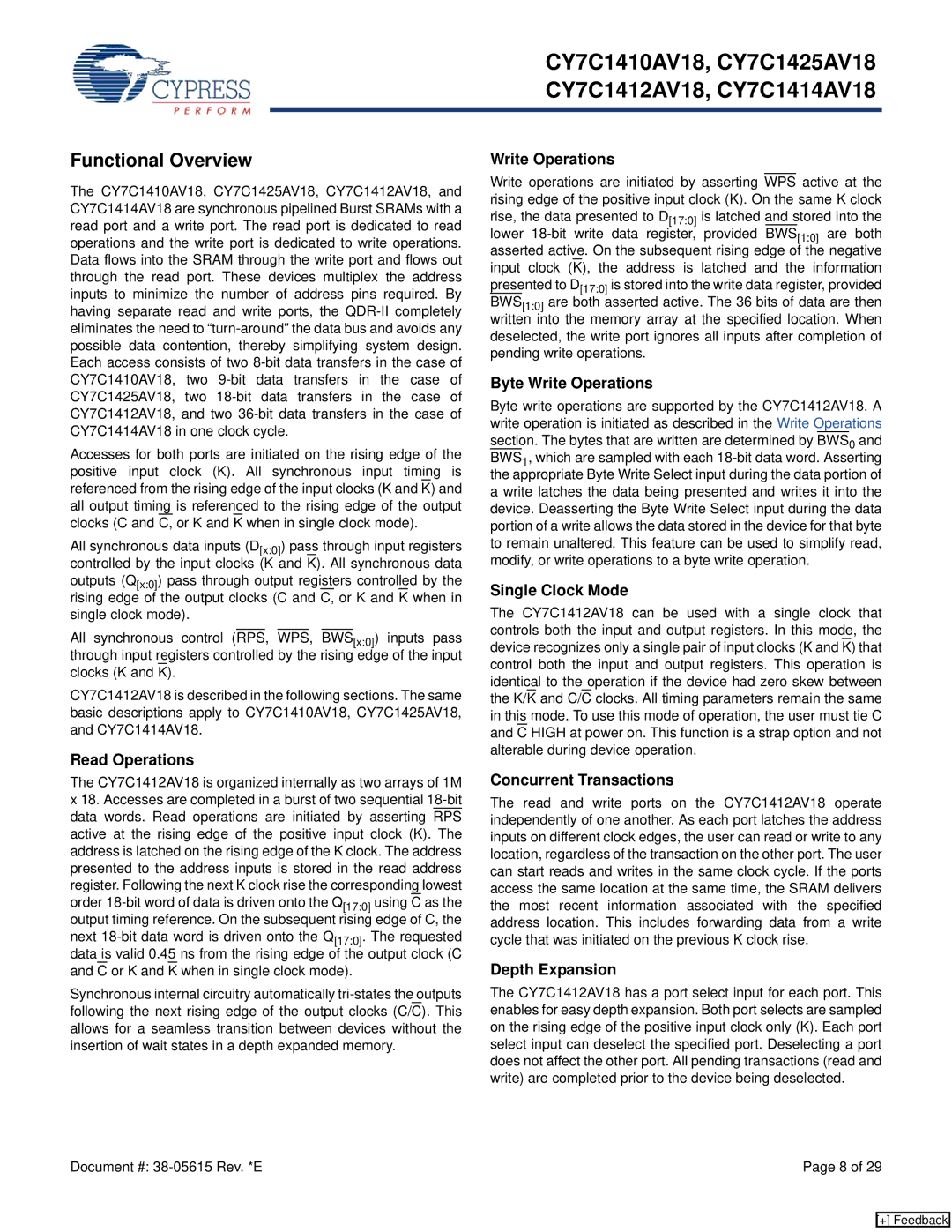Functional Overview
The CY7C1410AV18, CY7C1425AV18, CY7C1412AV18, and CY7C1414AV18 are synchronous pipelined Burst SRAMs with a read port and a write port. The read port is dedicated to read operations and the write port is dedicated to write operations. Data flows into the SRAM through the write port and flows out through the read port. These devices multiplex the address inputs to minimize the number of address pins required. By having separate read and write ports, the QDR-II completely eliminates the need to “turn-around” the data bus and avoids any possible data contention, thereby simplifying system design. Each access consists of two 8-bit data transfers in the case of CY7C1410AV18, two 9-bit data transfers in the case of CY7C1425AV18, two 18-bit data transfers in the case of CY7C1412AV18, and two 36-bit data transfers in the case of CY7C1414AV18 in one clock cycle.
Accesses for both ports are initiated on the rising edge of the positive input clock (K). All synchronous input timing is referenced from the rising edge of the input clocks (K and K) and all output timing is referenced to the rising edge of the output clocks (C and C, or K and K when in single clock mode).
All synchronous data inputs (D[x:0]) pass through input registers controlled by the input clocks (K and K). All synchronous data outputs (Q[x:0]) pass through output registers controlled by the rising edge of the output clocks (C and C, or K and K when in single clock mode).
All synchronous control (RPS, WPS, BWS[x:0]) inputs pass through input registers controlled by the rising edge of the input clocks (K and K).
CY7C1412AV18 is described in the following sections. The same basic descriptions apply to CY7C1410AV18, CY7C1425AV18, and CY7C1414AV18.
Read Operations
The CY7C1412AV18 is organized internally as two arrays of 1M x 18. Accesses are completed in a burst of two sequential 18-bit data words. Read operations are initiated by asserting RPS active at the rising edge of the positive input clock (K). The address is latched on the rising edge of the K clock. The address presented to the address inputs is stored in the read address register. Following the next K clock rise the corresponding lowest order 18-bit word of data is driven onto the Q[17:0] using C as the output timing reference. On the subsequent rising edge of C, the next 18-bit data word is driven onto the Q[17:0]. The requested data is valid 0.45 ns from the rising edge of the output clock (C and C or K and K when in single clock mode).
Synchronous internal circuitry automatically tri-states the outputs following the next rising edge of the output clocks (C/C). This allows for a seamless transition between devices without the insertion of wait states in a depth expanded memory.
Write Operations
Write operations are initiated by asserting WPS active at the rising edge of the positive input clock (K). On the same K clock rise, the data presented to D[17:0] is latched and stored into the lower 18-bit write data register, provided BWS[1:0] are both asserted active. On the subsequent rising edge of the negative input clock (K), the address is latched and the information presented to D[17:0] is stored into the write data register, provided BWS[1:0] are both asserted active. The 36 bits of data are then written into the memory array at the specified location. When deselected, the write port ignores all inputs after completion of pending write operations.
Byte Write Operations
Byte write operations are supported by the CY7C1412AV18. A write operation is initiated as described in the Write Operations section. The bytes that are written are determined by BWS0 and BWS1, which are sampled with each 18-bit data word. Asserting the appropriate Byte Write Select input during the data portion of a write latches the data being presented and writes it into the device. Deasserting the Byte Write Select input during the data portion of a write allows the data stored in the device for that byte to remain unaltered. This feature can be used to simplify read, modify, or write operations to a byte write operation.
Single Clock Mode
The CY7C1412AV18 can be used with a single clock that controls both the input and output registers. In this mode, the device recognizes only a single pair of input clocks (K and K) that control both the input and output registers. This operation is identical to the operation if the device had zero skew between the K/K and C/C clocks. All timing parameters remain the same in this mode. To use this mode of operation, the user must tie C and C HIGH at power on. This function is a strap option and not alterable during device operation.
Concurrent Transactions
The read and write ports on the CY7C1412AV18 operate independently of one another. As each port latches the address inputs on different clock edges, the user can read or write to any location, regardless of the transaction on the other port. The user can start reads and writes in the same clock cycle. If the ports access the same location at the same time, the SRAM delivers the most recent information associated with the specified address location. This includes forwarding data from a write cycle that was initiated on the previous K clock rise.
Depth Expansion
The CY7C1412AV18 has a port select input for each port. This enables for easy depth expansion. Both port selects are sampled on the rising edge of the positive input clock only (K). Each port select input can deselect the specified port. Deselecting a port does not affect the other port. All pending transactions (read and write) are completed prior to the device being deselected.

